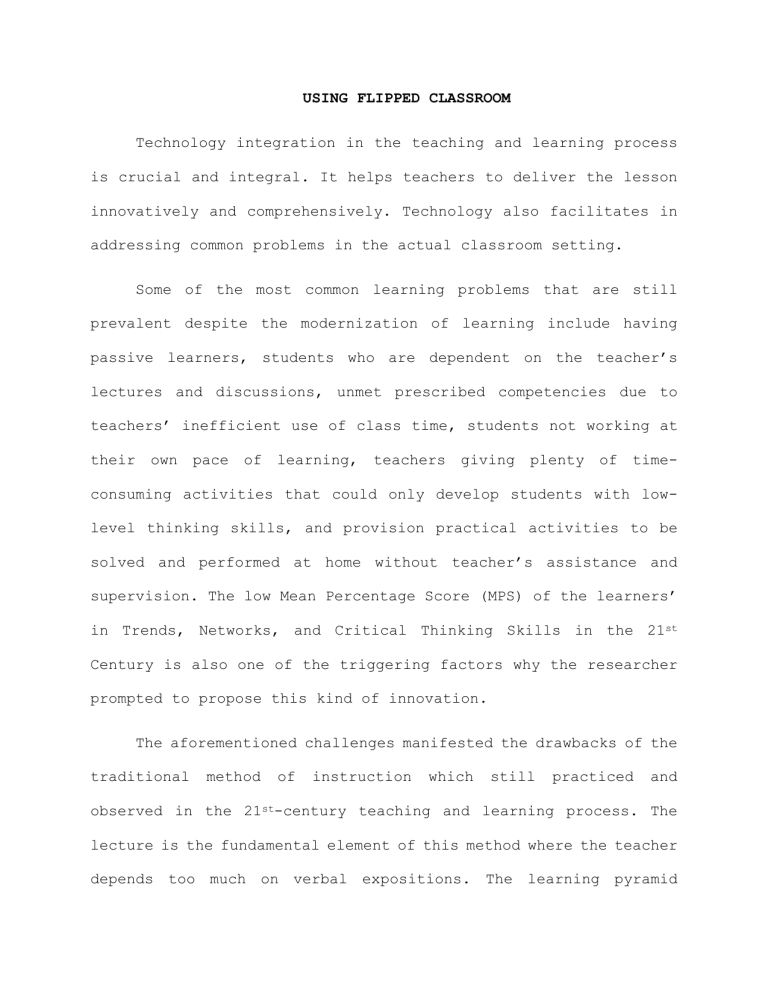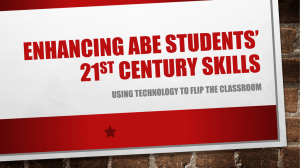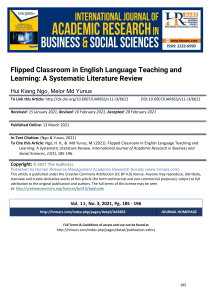
USING FLIPPED CLASSROOM Technology integration in the teaching and learning process is crucial and integral. It helps teachers to deliver the lesson innovatively and comprehensively. Technology also facilitates in addressing common problems in the actual classroom setting. Some of the most common learning problems that are still prevalent despite the modernization of learning include having passive learners, students who are dependent on the teacher’s lectures and discussions, unmet prescribed competencies due to teachers’ inefficient use of class time, students not working at their own pace of learning, teachers giving plenty of time- consuming activities that could only develop students with lowlevel thinking skills, and provision practical activities to be solved and performed at home without teacher’s assistance and supervision. The low Mean Percentage Score (MPS) of the learners’ in Trends, Networks, and Critical Thinking Skills in the 21st Century is also one of the triggering factors why the researcher prompted to propose this kind of innovation. The aforementioned challenges manifested the drawbacks of the traditional method of instruction which still practiced and observed in the 21st-century teaching and learning process. The lecture is the fundamental element of this method where the teacher depends too much on verbal expositions. The learning pyramid suggests that lecture is one of the most ineffective methods for learning and retaining information. A lecture is a passive form of learning wherein a learner simply sits back and listens to the information being spoon-fed by the teacher. Attempting to acquire information and gain understanding only through lectures is not the most effective way of learning.1 Research on classroom lectures has also demonstrated that a student’s attention declines after the first ten minutes of class, and although it may return at the end of a class, students remember only about 20 percent of the material presented during the lecture.2 Due to the increasing learning needs and diversity of 21stcentury learners, it is about time to change the traditional classroom instruction by taking advantage of advancements which facilitate in the development of students' performance and higherorder thinking skills. It is also a way to innovate instruction to the fullest where teachers and students can access and innovatively share information by using a variety of modes in meeting their teaching and learning needs. 1Loveless, B. and Betz, A. (2020). Education Corner. Retieved https://www.educationcorner.com/the-learning-pyramid on February 27, 2020 2 at Mohanty, A., & Parida, D. (2016). “Exploring the Efficacy & Suitability of Flipped Classroom Instruction at School Level in India: A Pilot Study” Creative Education, 7, 768-776. Retrieved from http://dx.doi.org/10.4236/ce.2016.75079 on February 17,2019. Flipped classroom is one of the most popular trends in instructional technology that does not only involve new technology; rather, it involves changing the traditional way of classroom instruction, and homeworks are managed by reversing the usual order of delivery.3 In this strategy, students learn by doing and teachers teach by questioning rather by telling or lecturing. Practical and hands-on activities and asking critical analysis questions are the forms of lecturing. This leads to the development, of the learners’ critical thinking and helping those who struggle with the lesson. Cheng-lin study revealed that students need not teachers’ explanation of the knowledge and skills in the traditional classroom they need more of timely and effective assistance when they encounter problems.4 The sense of responsibility and accountability of the students towards their learning is highly tested and developed in this innovation. The researcher did not only concentrate in making teachermade explainer video (audio-visual) as a usual mode in flipping the classroom, but rather, he integrated other modes such as purely visual and audio aids as tools in delivering the lesson that could be used to innovate the strategy in addressing the aforementioned 3 Cheng-lin, H. (2015) “A Study About Flipped Classroom Teaching Support System Design,” European Journal of Research and Reflection in Educational Sciences, Vol. 3 No. 1, 2015. 4 Ibid. challenges. Audio-visual aids are quite helpful in instruction. Researchers have recommended that the learning process should appeal to the mind chiefly through the auditory or visual sense organs since 85 percent of our learning may be absorbed through these senses.5 Studies also show that varying the study methods and materials will improve the retention and recall of information and enhance the learning experience.6 The researcher envisioned that through flipped classroom, the learners will become more responsible for their learning and improve their critical thinking skills, address long-term challenges in the classroom, and portray the 21st-century teaching and learning process. 5Retrieved from https://www.pblishing.com/ESSENTIALS-OF-INSTRUCTIONALTECHNOLOGY book/chapter-319-Chapter-2-AUDIO-VISUAL-AIDS on February 26,2020 6Loveless, B. and Betz, A., op.cit.,

